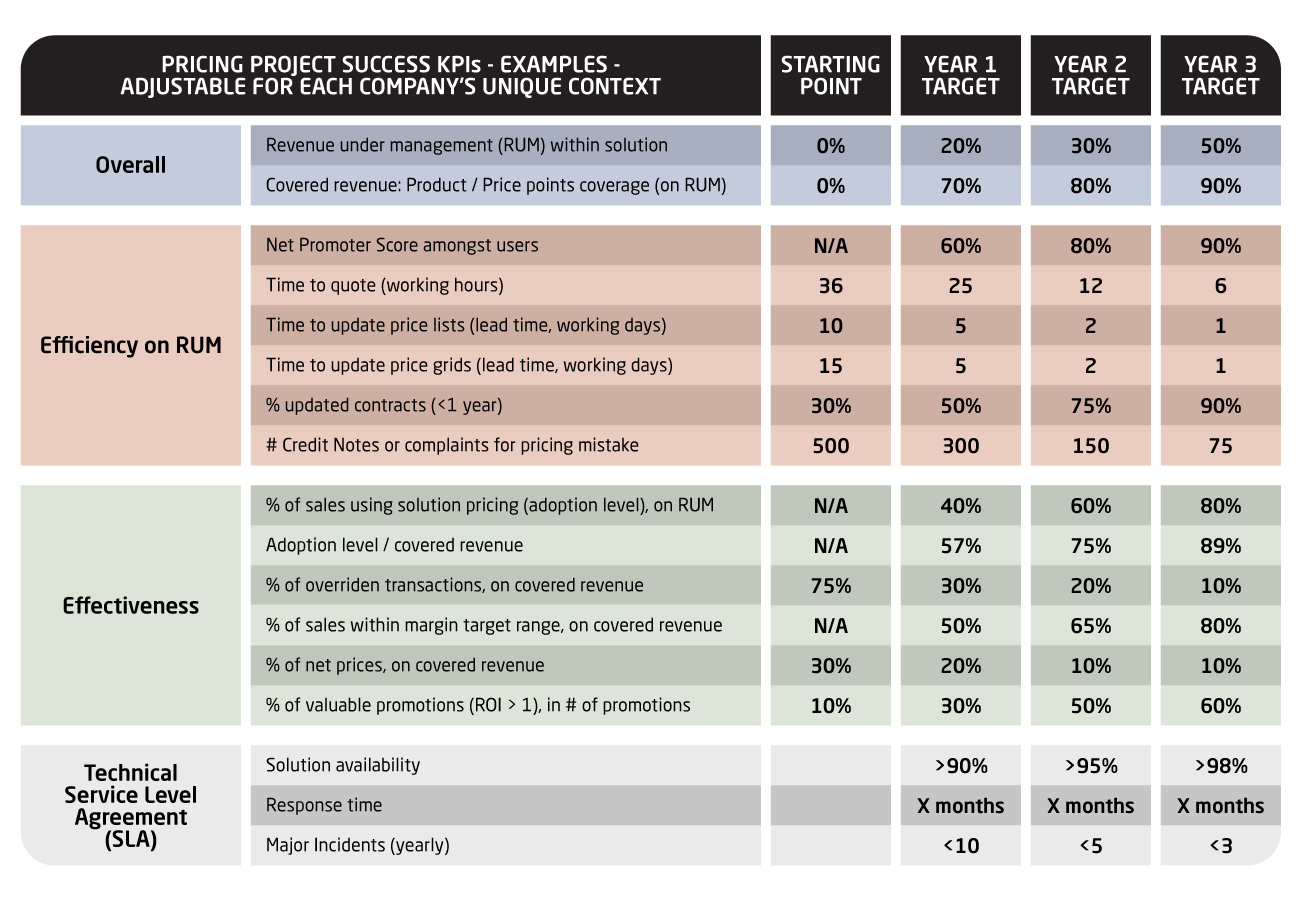Pricing Project Success: How to Define & Measure it
July 6th, 2023 (Updated 07/11/2023) | 11 min. read
Congratulations! You have successfully implemented your pricing software, a crucial step towards optimizing your organization’s pricing strategies. Now, it’s time to evaluate the post-implementation success of your pricing project and determine if the technology is truly helping you achieve your unique and overarching business objectives. In this article, we will guide you through the process of measuring the effectiveness of your pricing project, enabling you to gain valuable insights, make data-driven decisions, and ensure that your pricing strategies align with your organization’s goals.
At Pricefx and Converteo, together we have more than a combined 25 years in supporting business and pricing performance through data management and the implementation of quality pricing software. And one of the most-common questions we hear from our clients is ‘Once we have the tools for the job, how do we track if the technology is working or not?’
Let’s dive into the process of reviewing and grading the success of a pricing software project post-completion plus key methodologies and metrics that will help you gauge its success.
How to Grade the Success of a Pricing Software Project Post-Completion
Did you know that many clients and prospects often overlook the importance of grading and reviewing the success of a pricing software project? Consulting and integration partners often find themselves reminding their clients to consider this crucial aspect. Customers are often swayed by the promises of impressive return on investment and fail to define their own measures of success. However, this can lead to dissatisfaction down the line when expected results are not achieved, software adoption is lacking, or salespeople struggle to adapt. That’s why we believe in starting the process of measuring success from day one. We emphasize the need for clear expectations and goals, followed by collaborative workshops to define key performance indicators (KPIs) specific to each project phase. By setting timely KPIs and establishing an analysis framework for course correction, we ensure a continuous and proactive approach to measuring success.
To dive even deeper into the topic of KPIs and how they specifically apply in measuring the success of your pricing project, head to the section below ‘The KPIs Used to Assess Pricing Software Performance and Measuring Them’
Build a Solid Review Foundation
To grade and review the success of a pricing software project effectively, it’s essential to establish a solid foundation. This involves determining the primary goals and objectives of the project, whether it’s improving efficiency, effectiveness, reliability, or all of the above. Through collaborative workshops with our clients, we dive deep into defining key success indicators that align with these objectives and identify key pain points to eliminate.
The best way to design your success KPIs is to consider:
- What are my current pain points (no more than 3 or 4)
- What are the indicators I can use to quantify those pain points (e.g., time to quote or update price lists or grids, market share on some geographies or product lines or customer segments, share of low margin transactions etc.)
- How does technology answer those pain points, and which gains can I expect?
This methodology can switch your focus from traditional ROI considerations to your organization’s own context and your unique pain points for resolution.
Additionally, we recognize that success metrics may evolve over time, and thus we emphasize the importance of adapting KPIs to different project phases. This dynamic approach ensures that the measurement of success remains relevant and reflective of the changing needs and expectations.
Pricing is Ongoing – Not a ‘Set-and-Forget’
What’s more, we understand that success is not solely dependent on achieving predetermined KPIs. It requires proactive monitoring and analysis to identify areas where performance may fall short. By establishing a framework for analyzing and addressing suboptimal results, we empower our clients to take proactive measures for course correction. This not only helps them stay on track but also enables them to unlock the full potential of their pricing software investment. With our comprehensive approach to measuring success, our clients can confidently review and grade their pricing projects post-completion, ensuring that their organization’s unique goals are met and exceeded.
The KPIs Used to Assess Pricing Software Performance and Measuring Them
When it comes to assessing the performance of pricing software, it’s crucial to define the right KPIs that align with your high-level targets. We can categorize these KPIs into two main buckets: effectiveness and efficiency.
Effectiveness KPIs
Effectiveness looks at optimizing resources and achieving commercial targets, like market penetration and sales growth.
Efficiency KPIs
Efficiency, on the other hand, focuses on the success of your pricing process, such as revenue under management and Net Promoter Score (NPS), time to produce new quotes and price lists etc.
Realistic KPI Target Setting
It’s important to set realistic targets for each key performance indicator (KPI), considering distinct phases of your project and the desired outcomes over a two-year timeframe. Remember, simplicity is key, so aim for five KPIs per bucket to avoid overwhelming yourself with excessive data analysis.
While measuring the effectiveness of your pricing software, revenue under management can be a valuable KPI.

Set targets that gradually increase over time, starting at 20% in the first six months and reaching 70% in the following 18 months, eventually aiming for an impressive 96% coverage. Another effectiveness indicator could be the Net Promoter Score (NPS), especially in a B2B environment. Monitor how positively your salespeople advocate your pricing solution and aim for incremental improvements, targeting 50-60% in the initial phase, 80% in the next, and ultimately exceeding 90% satisfaction. By carefully defining these effectiveness indicators, you can track the impact of your pricing software on revenue generation and customer satisfaction.
Efficiency indicators focus on optimizing processes and resources. Consider metrics like market share, sales growth, and margin improvement. Depending on your business context, product categories, and customer segments, identify the key efficiency indicators that align with your goals. Remember, simplicity is crucial to avoid getting lost in complex analytics. Limiting yourself to five KPIs for efficiency will provide a clear and actionable framework for assessing the performance of your pricing software. By consistently monitoring these indicators, you can ensure that your pricing project is on track to meet its objectives and drive tangible value for your organization.
So, when it comes to measuring the success of your pricing software, remember to define the right KPIs aligned with your objectives, set realistic targets over a two-year timeframe, and keep it simple by focusing on five KPIs each for effectiveness and efficiency.
By doing so, you will be equipped with the necessary tools to evaluate the impact of your pricing project and make data-driven decisions that drive growth and profitability.
What Are Common Challenges When Reviewing the Success of Pricing Software Projects & How to Address Them?

When reviewing and grading the success of pricing software projects, several familiar challenges often arise.
Know Your Business Objectives
One of the main challenges is the lack of properly defined expectations and key performance indicators (KPIs) from the outset. To address this, it is essential to hold workshops with clients during the framing and design phases of the project. Collaboratively, the key targets, KPIs, and target values for each KPI can be established. This ensures alignment and clarity on the metrics that will be used to measure the success of the implementation.
Have a Single Source of ‘Data Truth’
Another challenge lies in having the necessary data sets, reporting mechanisms, and visualization tools in place to produce the identified KPIs. During the implementation phase, it becomes crucial to build analytics, dashboards, and reporting processes that progressively measure the results of the pricing software. This enables effective tracking and analysis of the project’s outcomes.
Analyze Results
In the post-implementation phase, it is essential to thoroughly analyze the results and identify the root causes of any performance gaps.
Three potential reasons for suboptimal performance often surface:
- Software underutilization
- Improper usage by users, and;
- Configuration issues.
By carefully examining these factors, it becomes possible to determine the areas that require attention and make necessary adjustments or provide additional training and support to address the identified challenges.
This type of proactive approach will ensure a more accurate assessment of project outcomes and facilitates continuous improvement and optimization.
How Can a Pricing Partner Help in Pricing Project Evaluation?
Let’s break it down.
When it comes to pricing project evaluation, a pricing partner is your trusty sidekick, there to save the day (and your sanity!).
Picture this: we kick off with a criteria of success workshop during the design phase. It’s like a brainstorming party, where we and our clients gather to set the stage for triumph. We define the KPIs, decide which data to use and lock in the target values. Voila! That’s step one, ensuring we know what success looks like down to the tiniest pricing detail.
Now, onto step two: we unleash our analytical prowess! With a sprinkle of magic (and a whole lot of technical expertise), we build the analytics and reporting mechanisms needed to bring those KPIs to life. Measuring KPIs builds a visual playground for all the pricing insights you will soon uncover.
And finally, the grand finale: step three, where we measure and analyze the results. This is where the real fun begins. We dive deep into the numbers, dissecting every digit, and unveiling the secrets hidden within. It’s like being detectives, searching for clues to unravel the mysteries of pricing success. Together, we’ll celebrate the wins, tackle the challenges, and make insightful data-driven decisions.
So, there you have it—a lively and entertaining take on how a pricing partner can lend a hand in pricing project evaluation.
Together, with your needs and our expertise, we’ll redefine success and turn your pricing dreams into a reality.
The Best Way to Find Value with Your Pricing Project
When it comes to finding value with your pricing project, there are a few things to keep in mind. Avoid the common pitfalls and uncover the best way to make the most of your investment.
One crucial aspect is to avoid selecting overly broad or challenging-to-analyze indicators when measuring return on investment. It is easy to fall into the trap of oversimplifying things and expecting pricing software to single-handedly revolutionize your marketing and sales efforts. However, relying solely on metrics like overall margin can lead to frustration and confusion. Margin is influenced by numerous factors beyond the scope of a pricing software, such as market fluctuations and competition. I have witnessed clients who based their project’s success solely on financial indicators, only to question the software’s effectiveness when margin improvements didn’t meet their lofty expectations. So, my advice is to strike a balance. Understand your project’s goals and why you are investing in it, but also be cautious not to be too generic in the indicators you choose.
Take the time to define meaningful key performance indicators (KPIs) that align with your specific objectives and remember that the value of a pricing software extends beyond traditional marketing and sales metrics.
Now, let’s delve deeper into unlocking the true value of pricing software. It is essential to broaden your perspective and embrace the multifaceted benefits that pricing software brings. Value can manifest in several ways beyond immediate marketing or sales indicators. Instead of solely focusing on financial gains, consider other aspects like process efficiency, customer satisfaction, or even strategic positioning.
By expanding your measurement criteria, you open the door to uncovering hidden gems of value that might have otherwise been overlooked. Embrace a comprehensive approach that captures the full range of impacts your pricing project has on your organization. Remember, the best way to find value is by taking a comprehensive view and selecting a diverse set of KPIs that align with your unique goals. So, think beyond the narrow confines of immediate financial gains and embrace the full spectrum of value waiting to be discovered within your pricing project.
The value offered by a quality pricing software solution like Pricefx is a key issue, and it is important to ensure that your pricing project delivers value to the customer and organization. To learn more about how to determine the value of pricing software to your company, check out this handy article below:
Happy Pricing!



